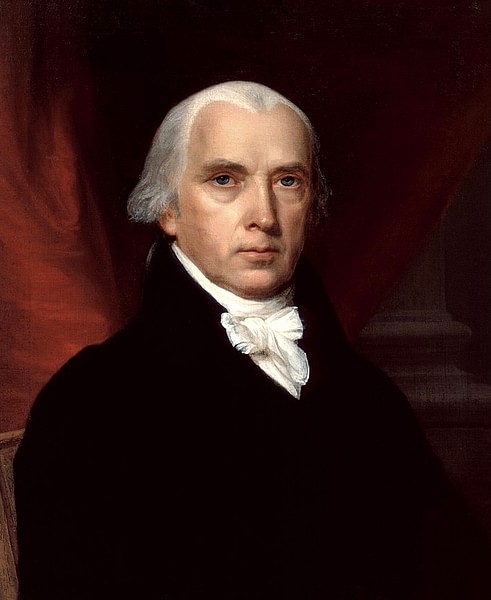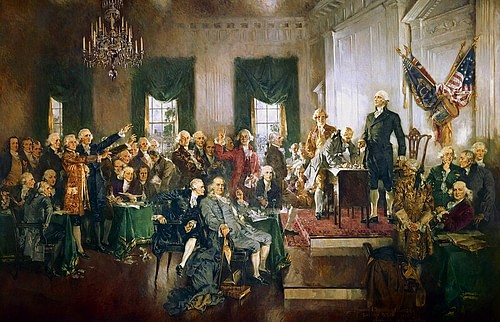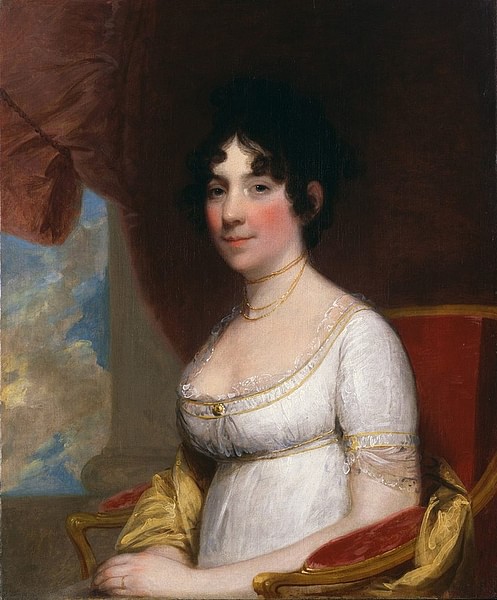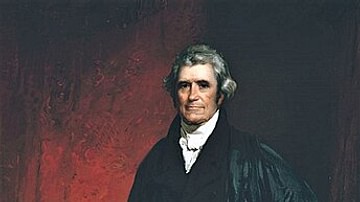
James Madison (1751-1836) was a statesman, diplomat, and a Founding Father of the United States, who served as the fourth US president from 1809 to 1817. He played an important role in the drafting of the United States Constitution and the implementation of the Bill of Rights, while his presidency was largely characterized by the War of 1812 against Britain.
Early Life
James Madison was born on 16 March 1751 on his grandmother's plantation, Belle Grove, in the British colony of Virginia. He was the oldest of twelve children born to James Madison Sr. and his wife Eleanor, of whom only seven would survive to adulthood. The elder Madison was one of the largest landowners in Virginia's Piedmont region, owning a 5,000-acre tobacco plantation later referred to as Montpelier, which was worked by approximately 100 slaves. Between the ages of 11 and 16, the young Madison was privately tutored in preparation for a college education. A serious and intellectually curious boy, Madison developed a fondness for studying and was particularly interested in the subjects of mathematics, geography, and languages, becoming proficient in Latin.
In 1769, Madison enrolled in the College of New Jersey (modern Princeton University), choosing it over the more local College of William and Mary because the New Jersey air was deemed better for his health. He underwent an intense study program – often sleeping less than five hours a night – and completed his undergraduate degree in only two years, graduating in 1771; because of this academic exertion, he became seriously ill and was unable to attend his commencement ceremony. He remained at Princeton for another year, studying Hebrew and political philosophy under the college's president, John Witherspoon (and a future signer of the Declaration of Independence). He returned to Montpelier in 1772 and was tasked by his father to tutor his younger siblings.
Revolution
As Madison was completing his studies, tensions between Great Britain and the Thirteen Colonies were worsening; Parliament's attempts to tax the colonies without their consent were considered unconstitutional, leading to boycotts, petitions, and even riots. Madison watched events unfold with keen interest, praising the Boston Tea Party in a letter to a friend and commenting that such demonstrations were necessary to "instruct in the art of defending liberty and property" (Feldman, 10). In December 1774, he took a seat on his local Committee of Safety, a revolutionary body tasked with enforcing the boycotts on British goods and readying Patriot militias for war. After the outbreak of the American Revolutionary War in April 1775, Madison was briefly commissioned as a colonel in the Orange County militia, serving as his father's second-in-command. He was unsuited for military life, however, due to the "discouraging feebleness" of his body, often experiencing severe migraines that prevented him from carrying out the military exercises (Feldman, 21). He soon resigned from the militia, having never seen any action.
Still determined to serve the revolution, Madison was elected as a delegate to the Fifth Virginia Convention in April 1776, which was charged with the creation of Virginia's constitution. He made his first political contribution at the convention, persuading his fellow delegates to accept a clause to the Virginia Declaration of Rights stating that "all men are equally entitled to the full and free exercise of [religion]" (Feldman, 26). The Declaration of Rights was ratified on 12 June 1776, less than a month before the United States declared its independence. The next year, Madison lost election to the Virginia House of Delegates after refusing to follow tradition by plying the voters with liquor, a practice that he felt was tantamount to buying votes. He was, however, selected to fill a vacancy on the Governor's Council, in which capacity he met Thomas Jefferson after the latter was elected governor in 1779. The two men worked closely with one another and eventually became good friends; historian Noah Feldman writes that their personalities complemented one another since "Jefferson inspired Madison, and Madison moderated Jefferson" (31).

In March 1780, Madison was sent as a delegate to the Continental Congress, where he witnessed firsthand the deficiencies of the national government under the Articles of Confederation. To protect the sovereignty of the states, Congress had deliberately kept itself weak and was unable to collect its own taxes or maintain a standing army, among other things. Madison soon realized that the new republic could not survive with such a weak central government and looked to strengthen it. Working with Alexander Hamilton, a young congressman from New York, he proposed to amend the Articles so that Congress could raise its own funds through tariffs on imports; though this proposal enjoyed the support of George Washington, it failed to be ratified by enough states. Frustrated, Madison left Congress after the end of the Revolutionary War in 1783 and returned to Virginia, where he continued to build his political profile in the state legislature. His most significant achievement here was in 1786, when he succeeded in passing the Virginia Statute for Religious Freedom, which challenged the Anglican Church's grip on spirituality in the commonwealth and promoted religious tolerance.
Father of the Constitution
Back in Virginia, Madison could not stop worrying about the weakness of the central government and decided to look into the issue himself. He asked Jefferson, who was serving as ambassador to France, to buy him books about international law, political philosophy, and the histories of contemporary and ancient republics; while no nation had been in the exact position the United States was in, Madison was able to use these examples to form his own political theory. After months of study, he produced the outline of what would become known as the Virginia Plan, which called for a strong central government split into three branches (executive, legislative, and judicial), with each branch exerting checks and balances on the powers of the others. This was done just in time for the Constitutional Convention of 1787, which was meeting in Philadelphia to revise – if not outright replace – the dysfunctional Articles of Confederation. In the days leading up to the Convention, Madison met with fellow Virginian delegates Edmund Randolph and George Mason to form a united front in favor of his plan.
Randolph presented the Virginia Plan to the Convention shortly after it opened, sparking weeks of debate. Although they were forced to yield to some compromises, Madison and his allies skillfully defended their plan, which ultimately served as the foundation for the United States Constitution, drafted at the Convention and signed on 17 September 1787. The Constitution was then sent to the states for ratification, sparking fierce debate between those who supported it – called Federalists – and those who opposed it, called Anti-Federalists. Working with Alexander Hamilton and John Jay, Madison helped pen a series of 85 essays in favor of ratification, collectively known as the Federalist Papers, which are considered some of the most significant political writings in US history. In 1788, Madison played a major role at Virginia's ratifying convention, in which he went toe-to-toe with Patrick Henry, a leading Anti-Federalist and one of the greatest orators of his age. Madison narrowly won out, and Virginia ended up ratifying the Constitution by a margin of 89-79.

The Constitution was soon ratified by the necessary nine states and went into effect on 4 March 1789, with the national hero George Washington chosen as the first president. Madison was elected to the First Congress and was quickly recognized as a leading voice in the House of Representatives. He was aware that the new government he had helped create rested on thin ice; most states had only narrowly voted for ratification, and many Anti-Federalists, concerned that the Constitution lacked any protections of specific liberties, clamored for a second constitutional convention to draft a framework more to their liking. To prevent this, Madison sponsored ten constitutional amendments that guaranteed certain liberties to American citizens like the freedoms of speech, assembly, and religion, the right to bear arms, and the right to jury trials. These ten amendments, called the Bill of Rights, quieted Anti-Federalist opposition when they were ratified on 15 December 1791. For his contributions to the Constitution itself and the Bill of Rights, Madison became known as the 'Father of the Constitution', a title that he humbly denied, claiming that it had been a collaborative effort.
Party Leader & Marriage
Around this time, Madison had a falling out with his old ally Hamilton, who had been appointed secretary of the treasury. Hamilton's plans to fund the national debt and establish a national bank were seen as favorable to the financial interests of the northern states, at the expense of the agrarian South; Madison, who had always considered himself a Virginian first and foremost, sided with his old mentor Jefferson in opposition to the Hamiltonian agenda. As time wore on, this polarization deepened and led to the formation of the first two political parties in the United States: Hamilton was recognized as the leader of the Federalist Party, which favored a powerful central government and pro-British policies, while Jefferson and Madison led the Democratic-Republican Party, which generally favored greater state sovereignty and supported the ideals of the French Revolution.
In 1794, Madison, a lifelong bachelor at 43, was introduced to Dolley Payne Todd, a beautiful, 26-year-old widow. The couple fell in love, and they were married on 15 September 1794, four months after having first met. Dolley Madison would end up being indispensable to her husband's political career; charming and sociable where James was often awkward, she played the role of hostess brilliantly, strengthening bonds with friends and winning over enemies at her famous dinner parties. She would carry this on into the White House, where she would help define the role of First Lady.
Secretary of State
Madison left Congress at the end of the Washington Administration, retiring with Dolley to Montpelier. They remained there for the next four years, although Madison continued to speak out against the Federalist administration of President John Adams. Then, after Jefferson's victory in the US presidential election of 1800, Madison was asked to serve as secretary of state. He accepted, and the Madisons arrived in the newly built national capital of Washington, D.C., in May 1801. As secretary of state, Madison was one of the most influential figures in Jefferson's cabinet and worked diligently to advance his friend's agenda. Acting on Jefferson's instructions, he refused to deliver commissions to the 'midnight judges' appointed by Adams before leaving office, leading to the landmark supreme court case Marbury v. Madison that established the principle of judicial review. Madison also helped oversee the Louisiana Purchase in 1803, which greatly expanded the size of the United States.
Madison continued to serve as secretary of state during Jefferson's second term, a period that saw deteriorating relations between the US and Britain. Each nation accused the other of failing to adhere to the terms of the Treaty of Paris of 1783, which had ended the Revolutionary War. Additionally, under the pretext of the ongoing Napoleonic Wars, the British had also begun to capture US merchant vessels that were suspected of trading at French ports and were impressing American sailors into service with the Royal Navy. The most egregious example of this was the Chesapeake-Leopard Affair, which occurred on 22 June 1807 when a British vessel fired on an American warship, killing and wounding American sailors. This was seen as an affront to both the honor and the sovereignty of the United States, and many Americans demanded action. Madison hoped that economic pressure would be enough to force Britain to end its attacks on US shipping and worked with Jefferson to pass the Embargo Act of 1807, which halted all exports to foreign ports. However, the embargo proved unpopular and ineffective and was repealed at the end of Jefferson's presidency.
President
Madison was widely viewed as Jefferson's natural successor and, in the US presidential election of 1808, he beat his Federalist opponent Charles Cotesworth Pinckney to secure the presidency. On 4 March 1809, he was inaugurated as the fourth US president, which was followed by a grand ball put together by Dolley. He appointed Albert Gallatin, one of the most influential Democratic-Republicans, as his secretary of the treasury and chose Robert Smith as secretary of state; when Smith proved incompetent, Madison was forced to handle all diplomatic work himself until 1811, when he finally replaced Smith with James Monroe. After this experience, Madison rarely called cabinet meetings and often consulted with Gallatin alone.
Tensions with Britain continued to escalate during Madison's first term. In Congress, a clique of young, hot-headed representatives emerged under the leadership of Henry Clay and John C. Calhoun, calling for a 'second war of independence' against the British. After winning reelection in 1812, Madison yielded to these 'War Hawks' and, in June, asked Congress for a declaration of war, which was granted. The ensuing War of 1812 was widely condemned by the Federalists, who derisively referred to it as 'Mr. Madison's War', but was supported by the Democratic-Republicans, who envisaged a quick and easy victory. This would not be the case; the US Army was woefully underprepared for a conflict and failed miserably in its first several attempts to invade the British colony of Canada. The fledgling US Navy proved more successful, winning several single-ship actions on the high seas that embarrassed the Royal Navy.
In 1814, as the Napoleonic Wars began to wind down in Europe, Britain was able to dedicate more military resources to fighting the Americans. On 24 August, a large British force landed at Chesapeake Bay and defeated an American force at the Battle of Bladensburg; Madison, who had been inspecting the troops when the British attacked, narrowly escaped capture. The British went on to capture Washington, D.C., burning many of its significant buildings like the Capitol and the White House. Dolley Madison managed to evacuate in time, famously rescuing the Gilbert Stuart portrait of George Washington in the process. On 24 December 1814, American and British diplomats signed the Treaty of Ghent, which ended the war and restored the pre-war borders. Although this might have been construed as a defeat, US honor was satisfied by Andrew Jackson's dramatic victory at the Battle of New Orleans (8 January 1815), fought before news of the peace reached US soil.
Thanks to Jackson's last-minute victory at New Orleans, the Madison administration was able to claim victory, leading to a surge in popularity for the Democratic-Republican Party. The Federalists were never able to recover popularity after their opposition to the war and would soon fade into irrelevance; their collapse marked an end to the partisan strife that had plagued US politics since the Washington administration, ushering in the so-called 'Era of Good Feelings'. Madison's last months in office were spent overseeing the reconstruction of Washington and supporting the candidacy of James Monroe, who won election in 1816. When Madison left office in March 1817, he was incredibly popular as evidenced by a letter that John Adams wrote to Jefferson, which claimed that Madison had "acquired more glory, and established more union, than all his three predecessors, Washington, Adams, and Jefferson, put together" (Feldman, 616).
Retirement & Death
In 1817, 65-year-old Madison returned to Montpelier where he began his retirement. He largely refrained from commenting on public affairs, refusing to comment on the Missouri Compromise or the four-way presidential contest in 1824. Along with Jefferson, he helped found the University of Virginia and served as its first rector, and also worked to help relocate freed slaves to the colony of Liberia in Africa; although he claimed to hate slavery as an institution and wished to see its abolition, Madison remained a lifelong slaveholder, leaving his slaves to Dolley in his will. His wealth dwindled in his later years, partially due to poor harvests and partially due to the gambling debts of his stepson John Payne Todd; in the 1830s, the Madisons were forced to mortgage half of the Montpelier plantation to free Todd from debtor's prison. To help ensure that Dolley was financially secure after he was gone, Madison spent his last years editing his notes and papers for publication. He died of heart failure at Montpelier on 28 June 1836 at the age of 85, leaving behind a legacy as one of the most consequential founders of the United States.










